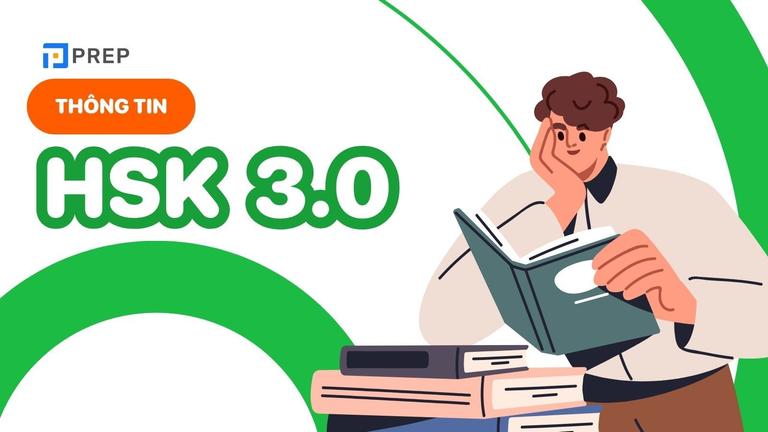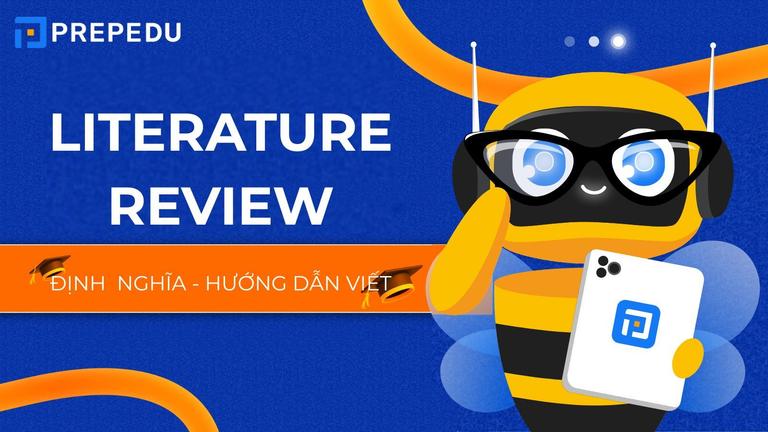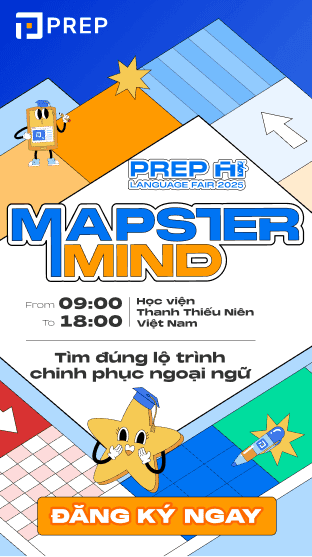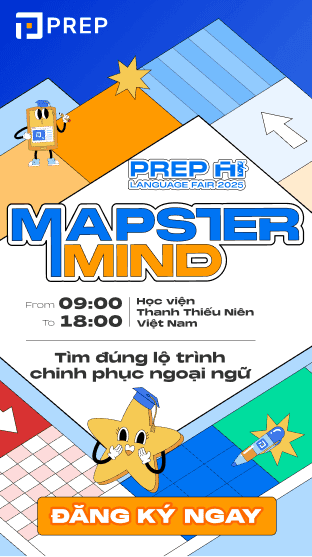Hướng dẫn viết Discussion Essay chi tiết và bài mẫu tham khảo
Không chỉ đơn thuần là viết theo quan điểm cá nhân, dạng bài Discussion Essay đòi hỏi thí sinh phải xem xét vấn đề từ nhiều góc độ, cân nhắc các luận điểm khác nhau trước khi đưa ra kết luận. Đây là dạng bài đòi hỏi khả năng lập luận chặt chẽ, tư duy phản biện tốt và vốn từ vựng học thuật đa dạng để có thể xử lý đề bài một cách toàn diện. Tuy nhiên, rất nhiều bạn thí sinh gặp khó khăn khi phải xác định cấu trúc bài viết phù hợp, chọn lọc từ ngữ để thể hiện ý một cách khách quan và vẫn giữ được tính thuyết phục trong lập luận.
Bài viết này sẽ giúp bạn giải quyết tất cả những vấn đề đó. Hãy cùng PREP khám phá từ A đến Z về dạng bài Discussion Essay – từ khái niệm, cấu trúc, cách lập dàn ý logic, đến chiến lược sử dụng từ nối và từ vựng theo chủ đề. Không chỉ dừng lại ở lý thuyết, bài viết còn mang đến cho bạn hai bài mẫu được phân tích chi tiết theo từng đoạn, giúp bạn dễ dàng hình dung và áp dụng khi viết bài thực tế.
Đầu tiên, bạn sẽ được làm quen với định nghĩa và đặc điểm nổi bật của dạng Discussion Essay. Sau đó, PREP sẽ chia sẻ cấu trúc chuẩn để triển khai một bài luận dạng này, bao gồm cả các dạng cấu trúc linh hoạt và nguyên tắc chung khi viết đoạn mở bài, thân bài và kết bài.
Bên cạnh đó, bạn sẽ được hướng dẫn từng bước cụ thể để viết bài Discussion Essay hiệu quả – từ việc phân tích đề, lên ý tưởng, viết nháp, chỉnh sửa và hoàn thiện bài viết. Ngoài ra, bài viết còn cung cấp các mẹo dùng từ chuyên sâu, bao gồm cách lựa chọn từ nối phù hợp, cách viết khách quan để tránh thiên vị, và làm sao để lồng ghép ý kiến cá nhân một cách mượt mà mà vẫn giữ được tính học thuật.
Cuối cùng, bạn sẽ được tham khảo hai bài mẫu chất lượng kèm theo phần phân tích chi tiết. Một bài ở dạng chỉ thảo luận hai ý kiến, và một bài kết hợp thảo luận với quan điểm cá nhân – cả hai đều xoay quanh các chủ đề quen thuộc như công nghệ và giáo dục, rất sát với đề thi thật.
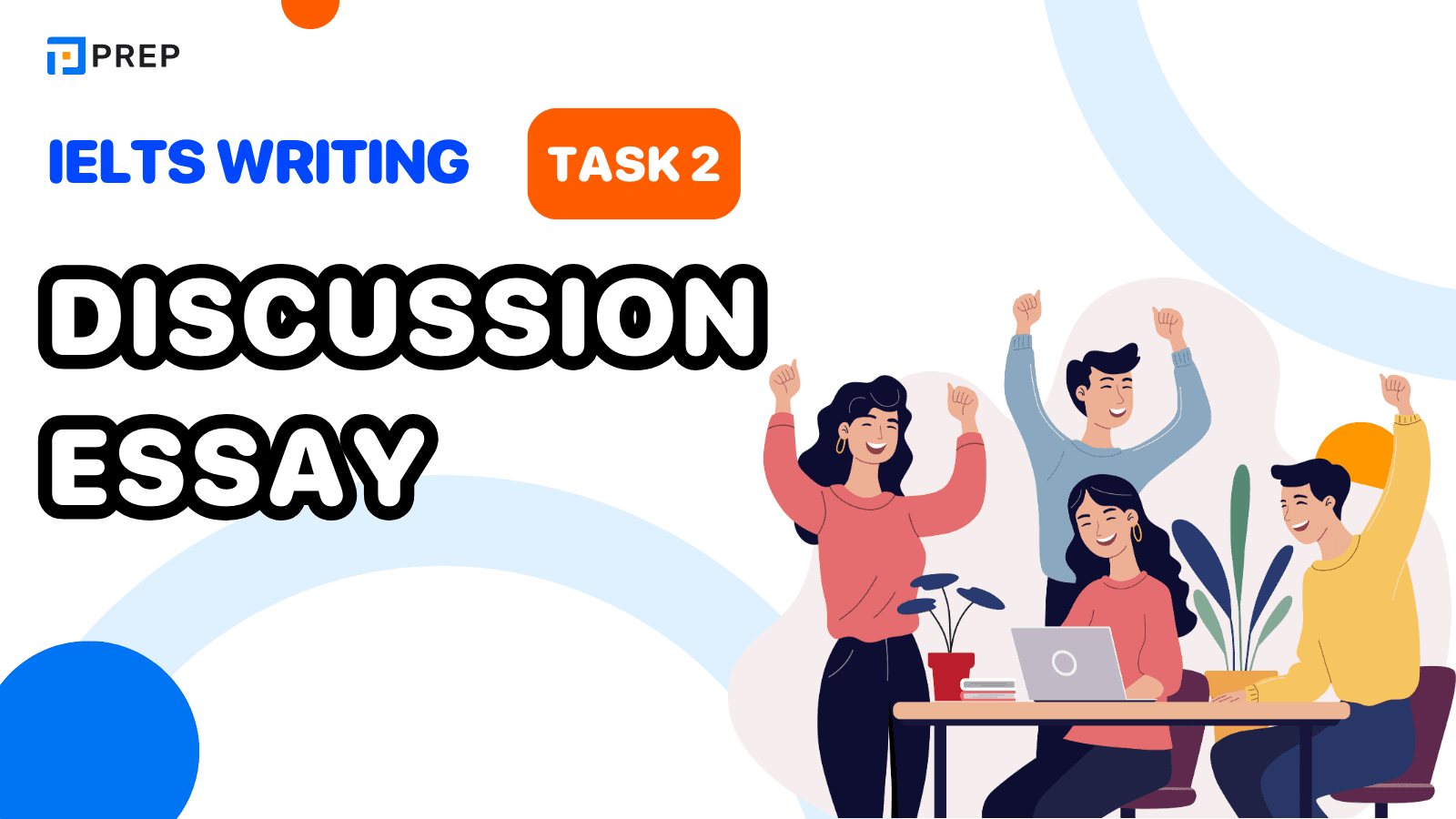
I. Tổng quan về dạng bài Discussion Essay trong đề thi Writing Task 2
1. Discussion Essay là gì?
Trong các dạng Writing Task 2, Discussion Essay sẽ đưa ra hai vấn đề/quan điểm trái ngược nhau, yêu cầu người viết bàn luận về cả hai vấn đề/quan điểm đó và sau đó đưa ra ý kiến cá nhân của mình. Khác với dạng bài Opinion Essay (chỉ tập trung vào một quan điểm), dạng bài Discussion essay đòi hỏi sự cân bằng và khách quan trong việc xem xét nhiều góc nhìn khác nhau của vấn đề.
Ví dụ: “Some people think that governments should give financial support to artists, musicians, and poets. Others think that it is a waste of money. Discuss both views and give your opinion.”
Mục đích cốt lõi của dạng bài Discussion Essay IELTS không phải là thuyết phục người đọc theo một hướng cụ thể, mà là trình bày một cách khách quan và cân bằng về các mặt khác nhau của vấn đề. Ở dạng bài này, bạn cần nghiên cứu và đánh giá các quan điểm, lập luận một cách công bằng, không thiên vị. Đây là cơ hội để bạn thể hiện khả năng tư duy phản biện và nhìn nhận vấn đề từ nhiều phía.

2. Cách nhận biết chi tiết dạng bài Discussion Essay
Discussion Essay là dạng bài yêu cầu bạn bàn luận cả hai quan điểm trái chiều và đưa ra ý kiến cá nhân. Đề bài thuộc dạng Discussion Essay thường có những cụm từ như:
-
Discuss both views and give your opinion
-
Discuss both these views and then give your own opinion
-
Discuss both sides of this argument and give your own opinion
Dù cách diễn đạt khác nhau, tất cả đều yêu cầu thí sinh thảo luận cả hai quan điểm và nêu rõ ý kiến cá nhân.
Ngoài ra, đề bài cũng luôn nêu ra hai quan điểm trái chiều. Bạn có thể dễ dàng nhận ra dạng bài này khi thấy đề bài nêu hai luồng ý kiến đối lập, chẳng hạn:
-
Some people believe that…
-
Others think that…
-
While some people say that..., others argue that...
Các cụm như “some people believe”, “others think” hoặc “there are different opinions” cũng là dấu hiệu điển hình của dạng Discussion Essay.
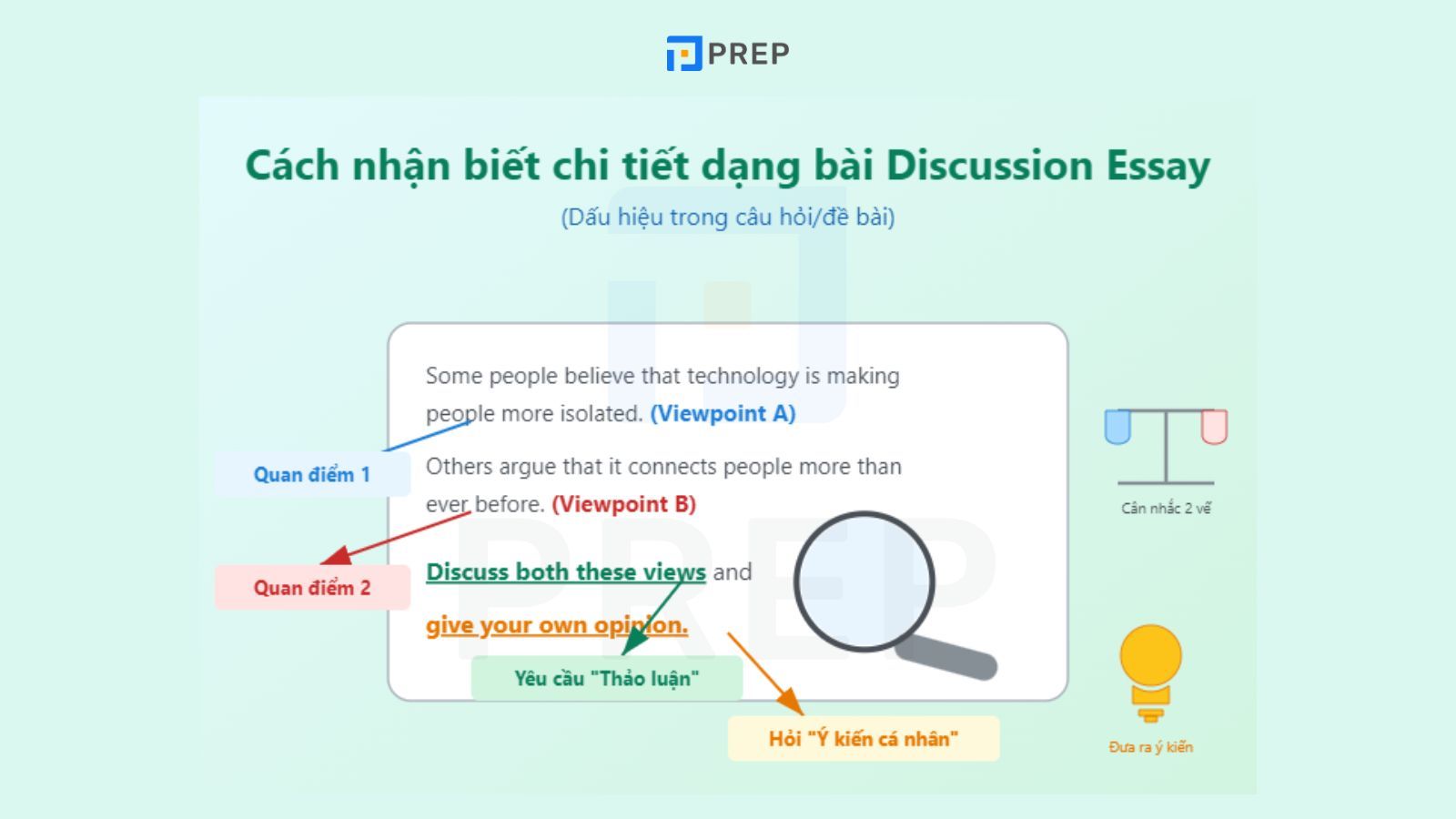
3. Phân biệt với các dạng bài khác
Thí sinh thường hay nhầm lẫn dạng Discussion Essay IELTS với các dạng như Opinion Essay và Advantages/Disadvantages Essay. Để tìm hiểu rõ hơn về sự khác nhau giữa các dạng bài này, hãy cùng tìm hiểu qua bảng sau nhé!
|
Tiêu chí |
Discussion Essay |
Opinion Essay (Agree/Disagree) |
Advantages/Disadvantages Essay |
|
Yêu cầu đề bài |
Thảo luận HAI quan điểm trái chiều và nêu rõ quan điểm cá nhân |
Trình bày ý kiến cá nhân đồng ý hay không đồng ý với MỘT quan điểm |
Phân tích ưu điểm và nhược điểm của một vấn đề, có thể yêu cầu thêm ý kiến cá nhân |
|
Từ khóa thường gặp trong đề |
|
|
|
II. Dàn bài và hướng dẫn cách viết Discussion Essay chi tiết
Để viết tốt dạng bài Discussion Essay trong IELTS Writing Task 2, bạn không chỉ cần nhận diện đúng đề bài mà còn phải xây dựng một dàn bài mạch lạc, hợp lý. Dưới đây là nguyên tắc chung, cấu trúc bài viết chuẩn và hướng dẫn cách viết Essay Discuss Both View từng phần giúp bạn triển khai đầy đủ cả hai quan điểm trái chiều, đồng thời trình bày rõ ràng quan điểm cá nhân của mình – đúng theo yêu cầu của đề bài. Cùng tìm hiểu nhé!
1. Nguyên tắc chung
Khi viết một bài Discussion Essay IELTS hiệu quả, có ba nguyên tắc chủ đạo cần tuân thủ:
-
Logic: Đảm bảo các ý tưởng được liên kết hợp lý, mạch lạc từ đầu đến cuối bài.
-
Mạch lạc: Các chuyển ý cần mượt mà, các đoạn văn liên kết chặt chẽ với nhau.
-
Cân bằng: Xem xét các mặt của vấn đề một cách tương đối đồng đều, không thiên vị.
2. Dàn ý chi tiết (Mẫu)
Một bài Discussion Essay hoàn chỉnh cần có cấu trúc rõ ràng gồm ba phần chính: mở bài, thân bài và kết bài.

2.1. Mở bài
Phần mở bài đóng vai trò quan trọng trong việc giới thiệu vấn đề và định hướng người đọc, bao gồm 3 phần chính:
-
Câu diễn giải lại đề bài (paraphrase): Trình bày lại vấn đề chính của đề bài bằng cách sử dụng từ đồng nghĩa và cấu trúc câu khác để tránh lặp lại.
-
Câu luận đề (thesis statement): Nêu rõ những nội dung chính sẽ được thảo luận trong bài, thường nằm ở cuối đoạn mở bài. Trong dạng bài discussion essay, câu này nên chỉ rõ bạn sẽ thảo luận những quan điểm nào và có thể báo trước ý kiến cá nhân.
-
Đưa ra ý kiến cá nhân (nếu đề bài yêu cầu)
Phần mở bài nên dài khoảng 2-3 câu, khoảng 40-60 từ và nên dành 5 phút để viết.
Khi viết mở bài, bạn không được lặp lại y nguyên câu hỏi trong đề bài. Thay vào đó, bạn cần paraphrase (viết lại bằng cách dùng từ/cấu trúc khác nhưng vẫn giữ nguyên ý). Có rất nhiều cụm từ giúp bạn làm điều này bao gồm:
-
Some people argue that... while others say that...
-
It is considered by some that... while others believe that...
-
It is often argued that... whilst others disagree and think that...
Ví dụ: “Some people think that children should begin their formal education at a very early age. Others believe that they should begin at least at 7 years old. Discuss both views and give your own opinion.”
Phần mở bài mẫu:
The question of when children should commence formal education has sparked significant debate among educators and parents worldwide. While some advocate for early academic instruction beginning as young as three or four years old, others maintain that children benefit more from delaying structured learning until they reach at least seven years of age. In my opinion, delaying formal education until children are at least seven years old allows them to develop more fully in other essential areas.
Phân tích phần mở bài:
-
Câu đầu paraphrase đề bài, đề cập đến "formal education" và sự tranh luận về thời điểm thích hợp.
-
Câu thứ hai nêu rõ hai quan điểm đối lập: một nhóm ủng hộ việc bắt đầu sớm (từ 3-4 tuổi), nhóm còn lại ủng hộ việc trì hoãn đến ít nhất 7 tuổi.
-
Câu thứ ba nêu quan điểm cá nhân, chọn lập trường ủng hộ việc học từ 7 tuổi trở lên
Như vậy, mở bài trên đã đáp ứng đầy đủ các yêu cầu đề ra.
2.2. Thân bài
Phần thân bài là nơi bạn phát triển các luận điểm chi tiết. Thông thường có 2 đoạn thân bài, mỗi đoạn thảo luận một khía cạnh hoặc quan điểm của vấn đề. Cấu trúc của mỗi phần thân bài thường như sau:
-
Câu chủ đề (topic sentence) nêu rõ quan điểm sẽ được thảo luận.
-
Phần giải thích/lập luận (explanation/argument) để làm rõ và phát triển quan điểm đó.
-
Cung cấp ví dụ/minh họa (example/evidence) cụ thể để hỗ trợ cho lập luận của bạn.
-
Cuối mỗi đoạn có thể có câu kết nối để chuyển sang ý tiếp theo một cách mượt mà.
Ví dụ minh họa: Với đề bài trên, PREP sẽ tiếp tục đưa ra ví dụ mẫu kèm phân tích để giúp bạn hiểu rõ cách viết hơn nhé!
|
Phần |
Nội dung |
Phân tích |
|
Thân bài thứ nhất |
On the one hand, some people believe that children should start school at an early age to maximize their learning potential. Research in neuroscience suggests that synaptic connections form most actively before age five, providing a unique window of opportunity for cognitive development. For example, countries like Singapore and South Korea, which consistently rank high in international education assessments, typically begin formal schooling at age four or five with a strong emphasis on foundational literacy and numeracy skills. |
|
|
Thân bài thứ hai |
On the other hand, others believe that starting formal education later allows children to develop emotionally and socially before facing academic pressure. They contend that premature academic pressure can lead to stress, anxiety, and even a long-term aversion to learning. For instance, the Finnish education system, consistently praised for its excellence despite fewer instructional hours, begins formal schooling at age seven, focusing instead on play-based learning in earlier years. |
|
2.3. Kết bài
Phần kết bài giúp tổng hợp và khép lại bài viết một cách hiệu quả:
-
Tóm tắt ngắn gọn các điểm chính đã thảo luận trong bài.
-
Tái khẳng định luận điểm/ý kiến của bạn một cách súc tích và rõ ràng.
-
Tránh đưa thêm ý tưởng mới vào phần kết bài.
Ví dụ phần kết bài mẫu:
In conclusion, while starting formal education at a very young age can capitalize on early neural plasticity and potentially reduce achievement gaps, delaying until age seven allows for crucial developmental processes to occur naturally through play and exploration. Personally, I support the idea of beginning formal education at the age of seven, as it aligns better with a child’s developmental needs.
Phân tích phần kết bài:
-
Câu mở đầu sử dụng "In conclusion" và tóm tắt hai quan điểm đã thảo luận
-
Tái khẳng định quan điểm cá nhân ủng hộ cách tiếp cận cân bằng, bắt đầu từ 5-6 tuổi
III. 5 bước chuẩn bị viết Discussion Essay IELTS hiệu quả
PREP sẽ chia sẻ cho bạn 5 bước đơn giản nhưng cực kỳ hiệu quả giúp bạn từng bước xây dựng một bài luận hoàn chỉnh, đúng yêu cầu đề bài và dễ dàng đạt điểm cao với dạng bài Discussion Essay:
1. Phân tích đề bài kỹ lưỡng
Phân tích đề bài là bước đầu tiên cực kỳ quan trọng giúp bạn viết đúng trọng tâm và không bị lạc đề. Bạn chỉ cần trả lời được 3 câu hỏi sau:
-
Đề bài đang nói về chủ đề gì? → Đây là nội dung chính bạn cần viết, thường liên quan đến một vấn đề xã hội, giáo dục, công nghệ…
-
Đề đang đưa ra những quan điểm nào? → Xác định rõ hai luồng ý kiến khác nhau mà bạn sẽ thảo luận trong bài.
-
Đề muốn bạn làm gì? → Đọc kỹ yêu cầu như “discuss both views and give your opinion” để biết bạn cần vừa phân tích cả hai quan điểm, vừa nêu rõ ý kiến cá nhân.
Hãy dành ít nhất 3-5 phút cho việc phân tích đề bài sẽ giúp bạn tránh lệch hướng khi viết.
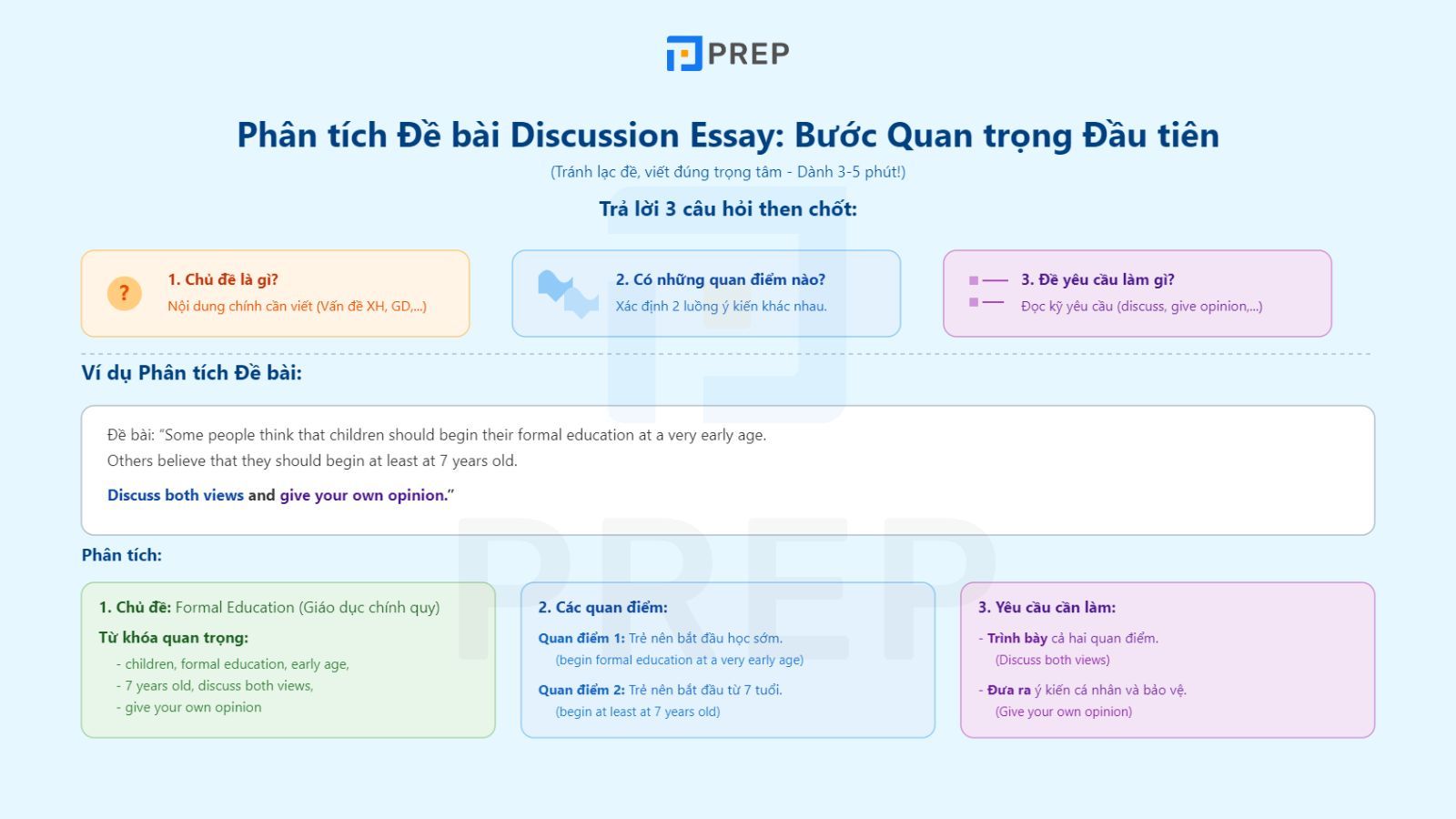
Ví dụ đề bài: “Some people think that children should begin their formal education at a very early age. Others believe that they should begin at least at 7 years old. Discuss both views and give your own opinion.”
Từ đề bài trên, bạn có thể dễ dàng phân tích đề bài:
-
Chủ đề: Formal Education
-
Các từ khóa quan trọng bao gồm: children, formal education, early age, 7 years old, discuss both views, give your own opinion.
-
Đề bài yêu cầu bạn thảo luận hai quan điểm trái ngược:
-
Một bên cho rằng trẻ nên bắt đầu học sớm (khi còn rất nhỏ).
-
Một bên cho rằng trẻ nên học chính thức từ ít nhất 7 tuổi trở đi.
-
-
Bạn cần:
-
Trình bày cả hai quan điểm.
-
Đưa ra ý kiến cá nhân và bảo vệ quan điểm đó.
-
2. Brainstorm ý tưởng có hệ thống
Sau khi hiểu rõ yêu cầu, hãy dành thời gian để brainstorm ý tưởng cho cả hai quan điểm. Bạn có thể sử dụng phương pháp vẽ mindmap hoặc liệt kê các ý tưởng theo cột để so sánh. Với mỗi quan điểm, cố gắng nghĩ ra 2-3 lập luận chính và ví dụ cụ thể đi kèm. Nếu đề bài yêu cầu nêu ý kiến cá nhân, hãy xác định rõ quan điểm của bạn và lý do ủng hộ. Sắp xếp các ý tưởng thành dàn bài logic, đảm bảo mỗi đoạn thân bài tập trung vào một ý chính.
Ví dụ: Với đề bài trên, bạn có thể liệt kê ý tưởng theo bảng như sau:
|
Quan điểm 1: Học từ sớm (early age) |
Quan điểm 2: Học từ 7 tuổi trở đi |
|
Phát triển trí não tốt hơn |
Có thêm thời gian chơi và phát triển tự nhiên |
|
Tạo nền tảng học thuật vững chắc |
Giảm áp lực học tập không cần thiết |
|
Cha mẹ có thể yên tâm gửi trẻ |
Phát triển cảm xúc, xã hội trước khi học chữ |
Ý kiến cá nhân: Tôi ủng hộ việc trẻ nên bắt đầu học từ 7 tuổi trở đi, vì điều đó giúp trẻ phát triển toàn diện về cảm xúc và xã hội trước khi tiếp cận môi trường học thuật.
3. Viết nháp tập trung vào luồng ý tưởng
Khi viết nháp, ưu tiên tập trung vào việc trình bày rõ ràng luồng ý tưởng thay vì lo lắng về ngữ pháp hoàn hảo. Bắt đầu với phần mở bài, nêu rõ vấn đề và cách tiếp cận của bạn. Trong các đoạn thân bài, đảm bảo mỗi đoạn bắt đầu bằng câu chủ đề rõ ràng, sau đó phát triển ý với giải thích và ví dụ cụ thể. Sử dụng các từ nối phù hợp để liên kết các ý và tạo sự mạch lạc. Khi viết phần kết bài, tóm tắt lại các điểm chính và khẳng định lại luận điểm (nếu cần). Quá trình viết nháp thường chiếm khoảng 20-25 phút.
Ví dụ:
-
Introduction: Paraphrase đề bài + Nêu rõ rằng bạn sẽ thảo luận cả hai quan điểm và bày tỏ ý kiến cá nhân.
-
Body 1: Trình bày quan điểm cho rằng trẻ nên bắt đầu học từ sớm → Lý do + ví dụ thực tế.
-
Body 2: Trình bày quan điểm nên học từ 7 tuổi → Lý do + ví dụ + kết hợp nêu rõ ý kiến cá nhân.
-
Conclusion: Tóm tắt lại hai quan điểm + Nhấn mạnh lại bạn chọn phương án nào và vì sao.
→ Ưu tiên triển khai logic các ý tưởng đã brainstorm, không cần quá lo về lỗi ngữ pháp ở bước này.

4. Chỉnh sửa cấu trúc và logic
Dành 5-7 phút để đọc lại và chỉnh sửa bài viết. Tập trung vào việc kiểm tra cấu trúc tổng thể, sự phát triển logic của các ý tưởng, và tính liên kết giữa các đoạn văn. Đảm bảo mỗi đoạn thân bài đều có câu chủ đề rõ ràng, giải thích đầy đủ, và ví dụ cụ thể. Kiểm tra xem bạn đã thảo luận cân bằng các quan điểm khác nhau chưa, và quan điểm cá nhân (nếu có) có được trình bày và bảo vệ một cách thuyết phục không. Điều chỉnh các chuyển ý để đảm bảo sự mạch lạc giữa các đoạn.
5. Chỉnh sửa cuối cùng về ngôn ngữ và hình thức
Dành 3-5 phút cuối cùng để rà soát lỗi ngữ pháp, từ vựng, chính tả và dấu câu. Kiểm tra việc sử dụng các thì trong tiếng Anh, sự hòa hợp giữa chủ ngữ và động từ, cách dùng giới từ, và các lỗi chính tả thông thường. Đảm bảo bạn đã sử dụng từ vựng đa dạng và phù hợp với chủ đề. Kiểm tra xem các từ nối đã được sử dụng chính xác để liên kết các ý tưởng. Cuối cùng, đảm bảo bài viết của bạn đáp ứng yêu cầu về độ dài (thường là khoảng 250-280 từ cho IELTS Writing Task 2).
Vậy làm thế nào để viết từng phần trong Discussion Essay? Sau khi đã nắm được các bước chuẩn bị viết một bài Discussion Essay hiệu quả, giờ là lúc bạn áp dụng chúng vào thực tế. Ở phần dưới đây, hãy cùng PREP đi vào hướng dẫn chi tiết cách viết Discussion Essay theo từng phần cụ thể trong bài luận, từ mở bài đến kết bài nhé!
IV. Cách dùng từ ngữ hay
Việc sử dụng từ ngữ linh hoạt, chính xác và tự nhiên là một trong những yếu tố quan trọng giúp bài viết hoặc bài nói của bạn trở nên thuyết phục và đạt điểm cao. Trong phần này, PREP sẽ chia sẻ cách lựa chọn và sử dụng từ ngữ hay cùng cách viết khách quan giúp bạn nâng tầm ngôn ngữ trong các bài thi và trong giao tiếp học thuật.
1. Từ nối cần biết
Từ nối đóng vai trò thiết yếu trong việc tạo sự mạch lạc cho bài discussion essay, giúp người đọc dễ dàng theo dõi luồng tư tưởng và chuyển ý của bạn. Một bài viết sử dụng từ nối phù hợp không chỉ trở nên mạch lạc hơn mà còn thể hiện khả năng ngôn ngữ học thuật cao.
Các nhóm từ nối phổ biến theo chức năng bao gồm:
-
Để thêm ý: Furthermore, additionally, moreover, in addition, also, what is more, besides, as well as, not only... but also
-
Để thể hiện tương phản: However, nevertheless, nonetheless, on the other hand, conversely, in contrast, despite, although, even though, while, whereas, yet, but
-
Để đưa ra ví dụ: For example, for instance, to illustrate, such as, particularly, specifically, notably, a case in point
-
Để thể hiện kết quả: Therefore, thus, consequently, as a result, hence, accordingly, for this reason, so, due to, because of, since
-
Để nêu ý kiến: In my opinion, from my perspective, I believe that, it seems to me that, as far as I am concerned, I would argue that, in my view
-
Để kết luận: In conclusion, to summarize, to sum up, in summary, overall, ultimately, all things considered, in a nutshell
Khi sử dụng từ nối, hãy đảm bảo rằng bạn hiểu rõ ý nghĩa và cách sử dụng đúng của mỗi từ. Ví dụ, "however" thường được dùng để giới thiệu một ý tưởng trái ngược với ý trước đó, trong khi "furthermore" được dùng để thêm thông tin hỗ trợ cho ý đã nêu. Sử dụng đa dạng các từ nối sẽ giúp bài viết của bạn trở nên phong phú và chuyên nghiệp hơn.
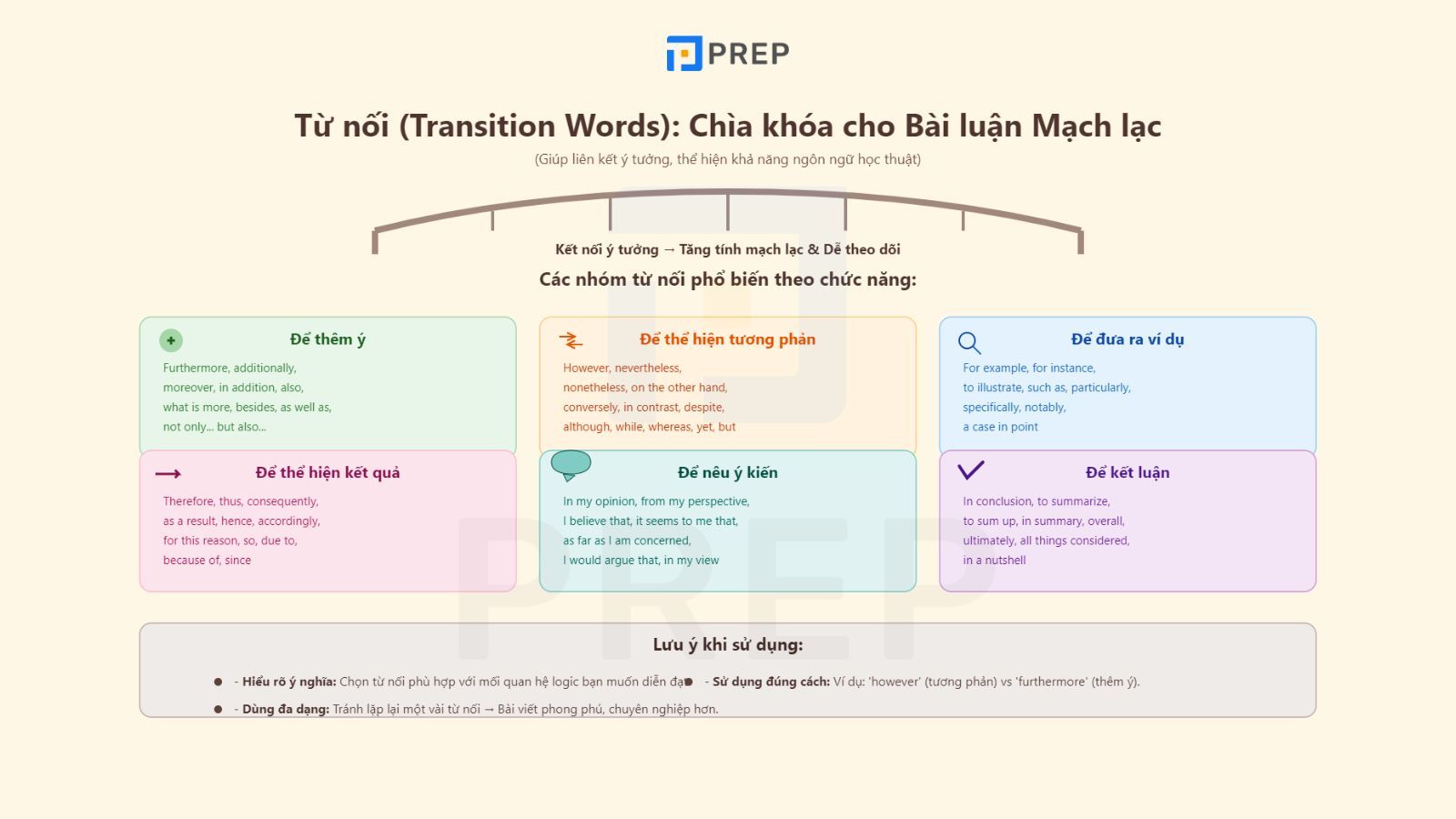
Nếu bạn muốn tìm hiểu chuyên sâu và đầy đủ hơn về từ nối (Linking Words) kèm bài tập thực hành, hãy tham khảo bài viết “Danh sách các từ nối trong tiếng Anh (Linking Words)” của PREP để nâng cao kiến thức nhé!
2. Dùng từ vựng theo chủ đề
Việc sử dụng từ vựng chính xác và liên quan đến chủ đề là yếu tố quan trọng giúp nâng cao chất lượng bài discussion essay. Thay vì sử dụng từ ngữ chung chung, hãy cố gắng sử dụng từ vựng học thuật và chuyên biệt theo từng chủ đề để thể hiện sự hiểu biết sâu sắc về vấn đề đang thảo luận.
Để làm được điều này, bạn nên xây dựng vốn từ vựng theo các chủ đề phổ biến trong IELTS như Môi trường, Công nghệ, Giáo dục, Y tế, Văn hóa, hoặc Kinh tế. Mỗi chủ đề sẽ có những thuật ngữ đặc thù mà nếu bạn sử dụng được sẽ làm tăng độ chính xác và sự thuyết phục cho bài viết của mình.
Nếu bạn vẫn chưa biết tìm tài liệu để học từ vựng theo chủ đề ở đâu thì bài viết “35 chuyên mục từ vựng IELTS theo chủ đề mới nhất” sẽ giúp ích cho bạn đó. Bài viết cung cấp cho bạn 3000+ từ vựng IELTS theo 35 chủ đề thông dụng nhất kèm cách học và tài liệu hiệu quả, giúp bạn nâng cao vốn từ của mình!
3. Cách viết khách quan và nêu ý kiến riêng
Trong discussion essay, việc duy trì giọng điệu khách quan khi trình bày các quan điểm khác nhau là rất quan trọng, đồng thời cũng cần biết cách thể hiện ý kiến cá nhân một cách hiệu quả khi đề bài yêu cầu.
Để viết khách quan, bạn có thể sử dụng các cấu trúc sau:
-
It is argued that...
-
Some people believe/claim/argue that...
-
Proponents of this view suggest that...
-
One perspective is that...
-
Many experts contend that...
-
According to some opinions,...
Khi bạn cần thể hiện ý kiến cá nhân rõ ràng, có thể sử dụng các cụm từ như:
-
In my opinion,...
-
I believe that...
-
From my perspective,...
-
It seems to me that...
-
After considering both sides, I am convinced that...
-
Having analyzed both viewpoints, I would argue that...
Lưu ý rằng ngay cả khi nêu quan điểm cá nhân, bạn vẫn nên duy trì giọng điệu học thuật và đưa ra lập luận logic thay vì chỉ đơn thuần nêu ý kiến mà không có cơ sở.
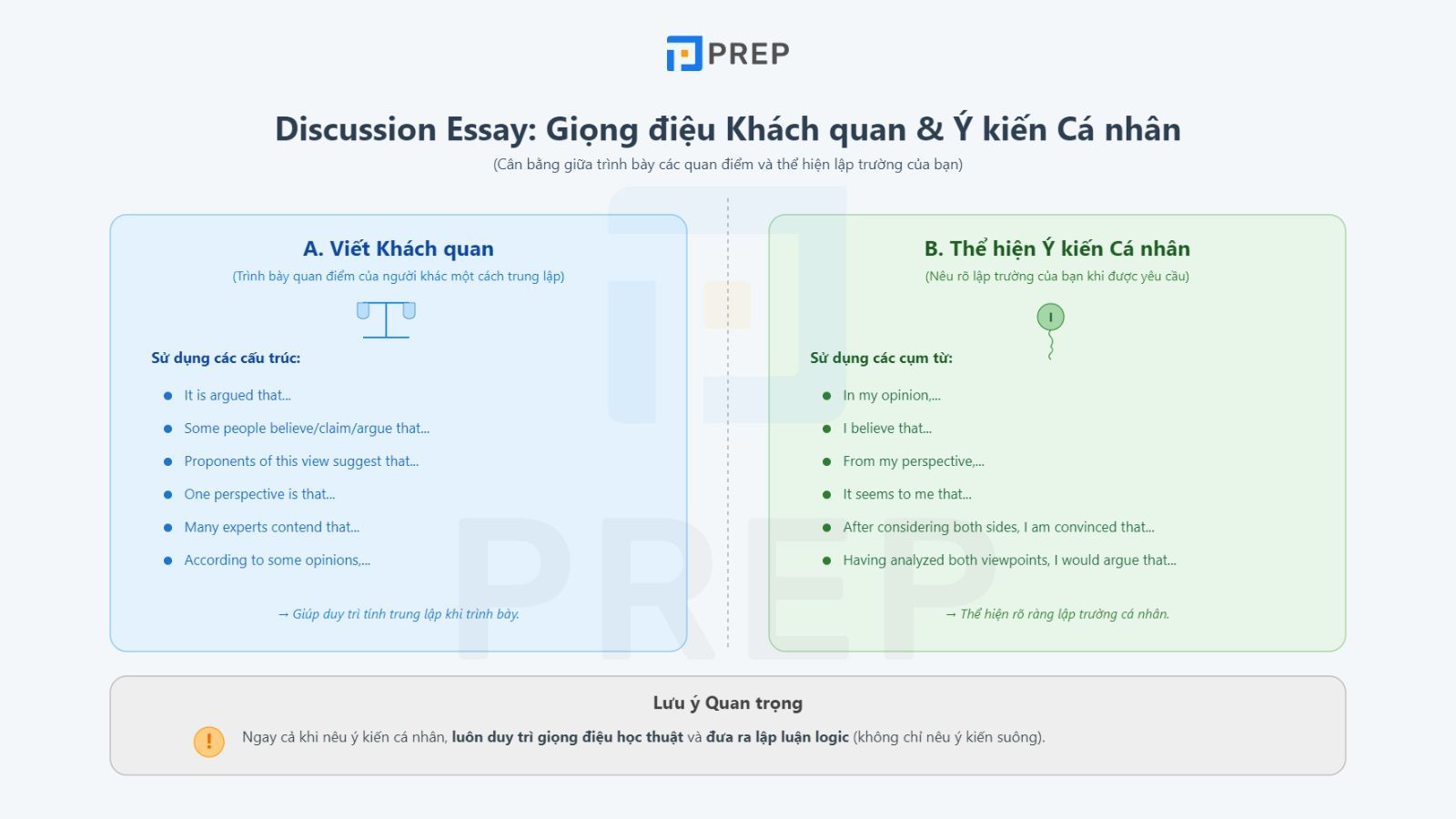
V. Một số bài mẫu về Discussion Essay
1. Đề bài IELTS Writing Task 2
1.1. Đề bài
"Some people think that environmental problems are too big for individuals to solve. Others believe individuals can also do some things to solve these problems. Discuss both views and give your own opinion"
1.2. Một số ideas/ opinion essay mẫu
Big problems:
-
Seawater pollution, caused by the activities of large companies (e.g. Formosa, a Taiwanese steel company, dumping untreated chemical waste into the sea in the middle of Vietnam) -> should be solved by the government (not individuals)
-
Global warming, which happens on a global scale -> should be solved by the international community (not individuals)
Small problems:
-
(1) Switch from cars and motorbikes to public transport => (2) reduce the amount of traffic emissions => (3) mitigate air pollution
-
(1) Recycle waste materials => (2) reduce the amount of waste which is buried underground in landfill sites => (3) alleviate soil pollution
Tham khảo thêm: Một số bài mẫu Discussion Essay band 7+ (Update liên tục)
2. Đề bài IELTS Writing Task 2 chủ đề Zoo
2.1. Đề bài
"Some people say that zoos have no useful purpose. Others believe that zoos are beneficial in many ways. Discuss and give your opinion"
2.2. Bài mẫu về cách viết Discuss both views
A diversity of animal species from leopards and eagles to lizards have been captured and kept in zoos across the globe for centuries. This practice is sometimes considered to be one that violates animal rights and causes these animals to lose their instincts. Despite these drawbacks, zoos are still beneficial, as they provide humans with a great place to learn about animals, and endangered animals with a great shelter.
Zoos, according to some, are valueless. There is a common belief that the act of caging an animal is already an infringement of animal rights. The matter can be even worse when some caged animals are bullied, mistreated and exploited when they are forced to perform in shows aimed at attracting visitors. Zoologists may also argue that these creatures may lose their natural instincts during the course of being captive, and they can be as a result incapable of returning to the wild in the future. A tiger, for example, may lose its hunting nature when it is fed on a daily basis.
However, there is compelling evidence that zoological gardens are invaluable not only for humans but also for the animals themselves. For young children and biology students, these venues can provide a resourceful learning environment, where both an understanding of and love for nature may easily evolve as physical contact with animals is possible. As a result, even the faunae from the furthest habitats such as penguins from the South Pole can be learnt about and appreciated. In addition to this, zoos have long offered to thousands of endangered species a home where they could thrive and breed their offspring. This has proved crucial as over-hunting, deforestation and climate change have threatened to destroy the natural habitats of some wild animals.
In conclusion, zoos are places where people learn about and develop their love for animals and where endangered species are nurtured and protected. These advantages outweigh the disadvantages, such as the chance that animals are exploited and bullied, or the possibility that they gradually lose their instincts. All these disadvantages can be lessened if more is invested in zoos to turn them into a better living space for animals.
Viết một bài discussion essay thành công đòi hỏi khả năng nhìn nhận vấn đề từ nhiều góc độ, phân tích các quan điểm khác nhau một cách khách quan, và trình bày lập luận logic. Thông qua việc nắm vững khái niệm, dàn bài, cách viết, các bước chuẩn bị và sử dụng từ ngữ phù hợp, bạn có thể tự tin đối mặt với dạng bài Discussion Essay trong kỳ thi IELTS Writing Task 2.
Hãy nhớ rằng, thực hành là chìa khóa để thành công. Càng viết nhiều dạng bài discussion essay, bạn càng phát triển khả năng phân tích vấn đề đa chiều, cấu trúc bài viết mạch lạc, và sử dụng ngôn ngữ học thuật hiệu quả. Các bài mẫu được cung cấp trong bài viết này không chỉ là mẫu để tham khảo mà còn giúp bạn hiểu được cách áp dụng lý thuyết vào thực tế viết.
Cuối cùng, hãy xem việc viết dạng bài discussion essay IELTS không chỉ là kỹ năng thi cử mà còn là cơ hội để phát triển tư duy phản biện và khả năng nhìn nhận vấn đề từ nhiều góc độ - những kỹ năng vô cùng quý giá trong học tập và công việc.
Học IELTS online dễ dàng hơn với PREP - Nền tảng Học & Luyện thi thông minh cùng AI. Nhờ công nghệ AI độc quyền, bạn có thể tự học trực tuyến ngay tại nhà, chinh phục lộ trình học IELTS hiệu quả. Bên cạnh đó, học viên còn có sự hỗ trợ tuyệt vời từ Teacher Bee AI, trợ lý ảo giúp bạn giải đáp thắc mắc và đồng hành 1-1 trong suốt quá trình học tập.
Hãy click TẠI ĐÂY hoặc liên hệ HOTLINE 0931428899 để nhận tư vấn chi tiết về các khóa học IELTS!
Tải ngay app PREP để bắt đầu hành trình học IELTS tại nhà với chương trình học luyện thi online chất lượng cao.

Chào bạn! Mình là Hiền Hoàng, hiện đang đảm nhận vai trò quản trị nội dung sản phẩm tại Blog của website prepedu.com.
Với hơn 5 năm tự học các ngoại ngữ như tiếng Anh, tiếng Trung và ôn luyện một số kỳ thi IELTS, TOEIC, HSK, mình đã tự đúc rút được nhiều kinh nghiệm để hỗ trợ hàng nghìn người đang gặp khó khăn trong việc học ngoại ngữ. Hy vọng rằng những chia sẻ phía trên sẽ giúp ích cho bạn trong quá trình tự ôn luyện thi hiệu quả tại nhà!
Bình luận
Nội dung premium
Xem tất cảLộ trình cá nhân hoá
Có thể bạn quan tâm
Kết nối với Prep

MSDN: 0109817671.
Địa chỉ liên hệ: Tòa nhà Vinaconex, 34 Láng Hạ, phường Láng, TP Hà Nội.
Trung tâm CSKH tại HN: Lô 21 C2 Khu đô thị Nam Trung Yên, phường Yên Hòa, TP Hà Nội.
Trung tâm CSKH tại HCM: 288 Pasteur, Phường Xuân Hòa, TP Hồ Chí Minh
Trụ sở Công ty: Số nhà 20, ngách 234/35 đường Hoàng Quốc Việt, phường Nghĩa Đô, TP Hà Nội.
Phòng luyện ảo - Trải nghiệm thực tế - Công nghệ hàng đầu.
Hotline: 0931 42 8899.
Trụ sở Công ty: Số nhà 20, ngách 234/35 đường Hoàng Quốc Việt, phường Nghĩa Đô, TP Hà Nội.
Giấy chứng nhận hoạt động đào tạo, bồi dưỡng số 1309/QĐ-SGDĐT ngày 31 tháng 07 năm 2023 do Sở Giáo dục và Đào tạo Hà Nội cấp.



